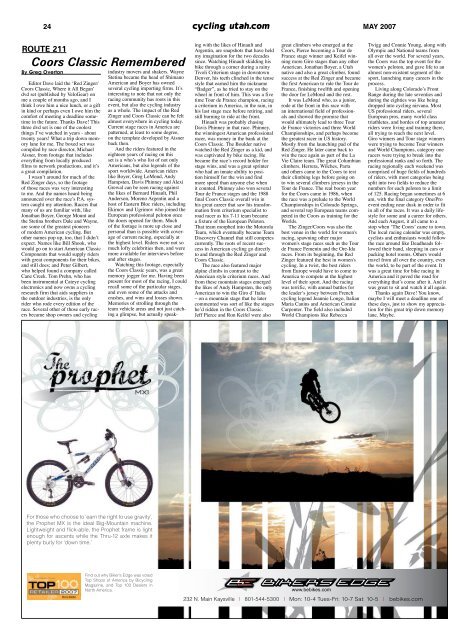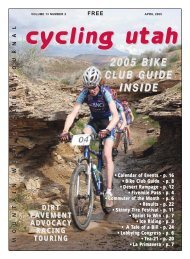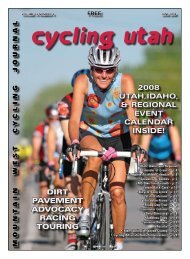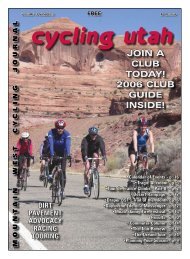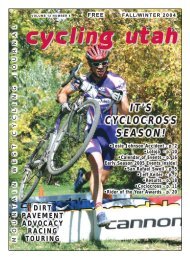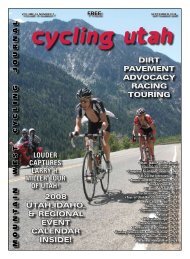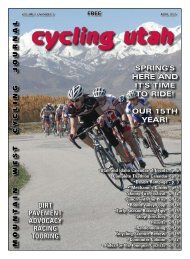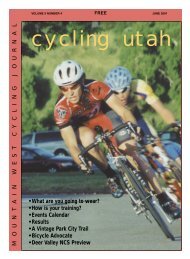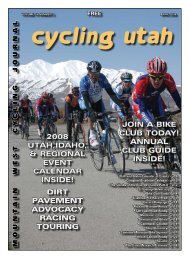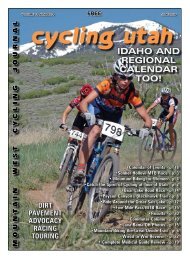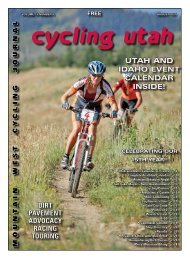DIRT PaVEMEnT aDVoCaCY RaCIng ToURIng ... - Cycling Utah
DIRT PaVEMEnT aDVoCaCY RaCIng ToURIng ... - Cycling Utah
DIRT PaVEMEnT aDVoCaCY RaCIng ToURIng ... - Cycling Utah
- No tags were found...
You also want an ePaper? Increase the reach of your titles
YUMPU automatically turns print PDFs into web optimized ePapers that Google loves.
24 cycling utah.com MAY 2007ROUTE 211Coors Classic RememberedBy Greg OvertonEditor Dave laid the ‘Red Zinger/Coors Classic, Where it All Began’dvd set (published by VeloGear) onme a couple of months ago, and Ithink I owe him a nice lunch, or a giftin kind or perhaps even I owe him thecomfort of meeting a deadline sometimein the future. Thanks Dave! Thisthree dvd set is one of the coolestthings I’ve watched in years - abouttwenty years! What a trip down memorylane for me. The boxed set wascompiled by race director, MichaelAisner, from footage that includeseverything from locally producedfilms to network productions, and it’sa great compilation.I wasn’t around for much of theRed Zinger days, so the footageof those races was very interestingto me. And the names heard beingannounced over the race’s P.A. systemcaught my attention. Racers thatmany of us are familiar with, likeJonathan Boyer, George Mount andthe Stetina brothers Dale and Wayne,are some of the greatest pioneersof modern American cycling. Butother names pop up, too, that I didn’texpect. Names like Bill Shook, whowould go on to start American ClassicComponents that would supply riderswith great components for their bikes,and still does; and Peter Gilbert,who helped found a company calledCane Creek. Tom Prehn, who hasbeen instrumental at Cateye cyclingelectronics and now owns a cyclingresearch firm that aids suppliers inthe outdoor industries, is the onlyrider who rode every edition of therace. Several other of those early racersbecame shop owners and cyclingindustry movers and shakers. WayneStetina became the head of ShimanoAmerican and Boyer has ownedseveral cycling importing firms. It’sinteresting to note that not only theracing community has roots in thisevent, but also the cycling industryas a whole. The impact of the RedZinger and Coors Classic can be feltalmost everywhere in cycling today.Current stage races in America arepatterned, at least to some degree,on the template developed by Aisnerback then.And the riders featured in theeighteen years of racing on thisset is a who’s who list of not onlyAmericans, but also legends of thesport worldwide. American riderslike Boyer, Greg LeMond, AndyHampsten, Davis Phinney and AlexiGrewal can be seen racing againstthe likes of Bernard Hinault, PhilAnderson, Moreno Argentin and ahost of Eastern Bloc riders, includingEkimov and Ugrimov who joined theEuropean professional peloton oncethe doors opened for them. Muchof the footage is more up close andpersonal than is possible with coverageof current racing, especially atthe highest level. Riders were not somuch lofty celebrities then, and weremore available for interviews beforeand after stages.Watching this footage, especiallythe Coors Classic years, was a greatmemory jogger for me. Having beenpresent for most of the racing, I couldrecall some of the particular stages,and even some of the attacks andcrashes, and wins and losses shown.Memories of strolling through theteam vehicle areas and not just catchinga glimpse, but actually speakingwith the likes of Hinault andArgentin, are snapshots that have heldmy imagination for the two decadessince. Watching Hinault skidding hisbike through a corner during a rainyTivoli Criterium stage in downtownDenver, his teeth clinched in the tensestyle that earned him the nickname“Badger”, as he tried to stay on thewheel in front of him. This was a fivetime Tour de France champion, racinga criterium in America, in the rain, inhis last stage race before retiring, andstill burning to ride at the front.Hinault was probably chasingDavis Phinney in that race. Phinney,the winningest American professionalracer, was money in the bank at theCoors Classic. The Boulder nativewatched the Red Zinger as a kid, andwas captivated by bike racing. Hebecame the race’s record holder forstage wins, and was a great sprinterwho had an innate ability to positionhimself for the win and findmore speed than anyone else whenit counted. Phinney also won severalTour de France stages and the 1988final Coors Classic overall win inhis great career that saw his transformationfrom criterium specialist toroad racer as his 7-11 team becamea fixture of the European Peloton.That team morphed into the MotorolaTeam, which eventually became TeamDiscovery Channel that still competescurrently. The roots of recent successin American cycling go directlyto and through the Red Zinger andCoors Classic.The race also featured majoralpine climbs in contrast to theAmerican style criterium races. Andfrom these mountain stages emergedthe likes of Andy Hampsten, the onlyAmerican to win the Giro d’ Italia– on a mountain stage that he latercommented was sort of like the stageshe’d ridden in the Coors Classic.Jeff Pierce and Ron Keifel were alsogreat climbers who emerged at theCoors, Pierce becoming a Tour deFrance stage winner and Keifel winningmore Giro stages than any otherAmerican. Jonathan Boyer, a <strong>Utah</strong>native and also a great climber, foundsuccess at the Red Zinger and becamethe first American to ride the Tour deFrance, finishing twelfth and openingthe door for LeMond and the rest.It was LeMond who, as a junior,rode at the front in this race withan international field of professionalsand showed the promise thatwould ultimately lead to three Tourde France victories and three WorldChampionships, and perhaps becomethe greatest racer in US history.Mostly from the launching pad of theRed Zinger. He later came back towin the race again as part of the LaVie Claire team. The great Columbianclimbers, Herrera, Wilches, Parraand others came to the Coors to testtheir climbing legs before going onto win several climbers jerseys in theTour de France. The real boom yearfor the Coors came in 1986, whenthe race was a prelude to the WorldChampionships in Colorado Springs,and several top European teams competedin the Coors as training for theWorlds.The Zinger/Coors was also thebest venue in the world for women'sracing, spawning other majorwomen's stage races such as the Tourde France Femenin and the Ore-Idaraces. From its beginning, the RedZinger featured the best in women'scycling. In a twist, the best ridersfrom Europe would have to come toAmerica to compete at the highestlevel of their sport. And the racingwas terrific, with annual battles forthe leader’s jersey between Frenchcycling legend Jeannie Longo, ItalianMaria Canins and American ConnieCarpenter. The field also includedWorld Champions like RebeccaTwigg and Connie Young, along withOlympic and National teams fromall over the world. For several years,the Coors was the top event for thewomen's peloton, and gave life to analmost non-existent segment of thesport, launching many careers in theprocess.Living along Colorado’s FrontRange during the late seventies andduring the eighties was like beingdropped into cycling nirvana. MostUS professional riders, severalEuropean pros, many world classtriathletes, and hordes of top amateurriders were living and training there,all trying to reach the next level.Giro winners and Tour stage winnerswere trying to become Tour winnersand World Champions, category oneracers were trying to break into theprofessional ranks and so forth. Theracing regionally each weekend wascomprised of huge fields of hundredsof riders, with most categories beingsplit into two fields to reduce thenumbers for each peloton to a limitof 125. Racing began sometimes at 6am, with the final category One/Proevent ending near dusk in order to fitin all of the races. It was a daily lifestylefor some and a career for others.And each August, it all came to astop when ‘The Coors’ came to town.The local racing calendar was empty,cyclists and enthusiasts would followthe race around like Deadheads followedtheir band, sleeping in cars orpacking hotel rooms. Others wouldtravel from all over the country, eventhe world, to be part of the event. Itwas a great time for bike racing inAmerica and it paved the road foreverything that’s come after it. And itwas great to sit and watch it all again.Thanks again Dave! You know,maybe I will meet a deadline one ofthese days, just to show my appreciationfor this great trip down memorylane. Maybe.For those who choose to ‘earn the right to use gravity’,the Prophet MX is the ideal Big-Mountain machine.Lightweight and flick-able, the Prophet frame is lightenough for ascents while the Thru-12 axle makes itplenty burly for ‘down time.’Find out why Biker’s Edge was votedTop Shops of America by BicyclingMagazine, and Top 100 Dealers inNorth America.www.bebikes.com232 N. Main Kaysville | 801-544-5300 | Mon: 10-4 Tues-Fri: 10-7 Sat: 10-5 | bebikes.com


